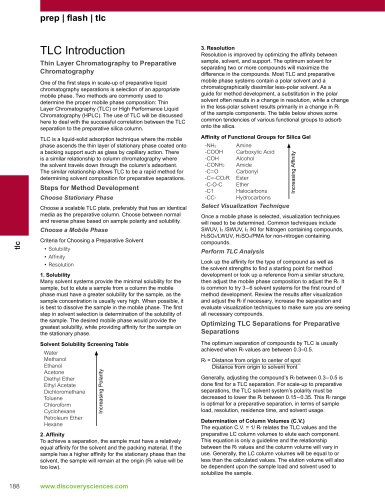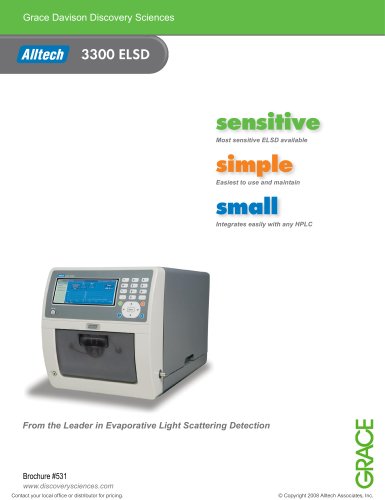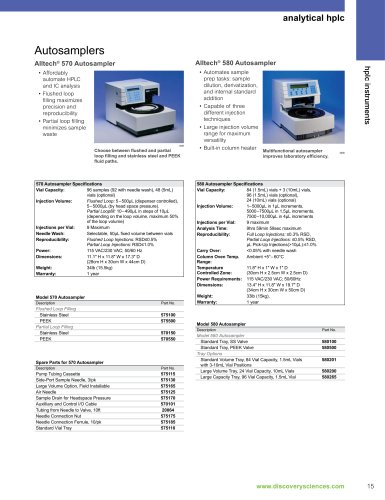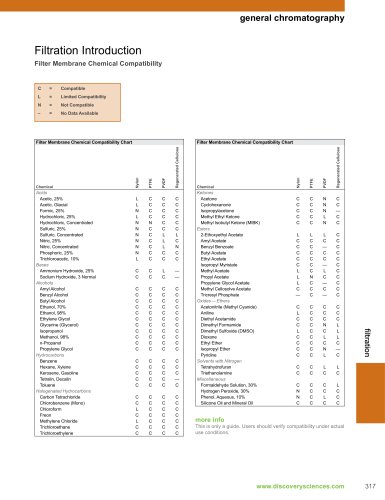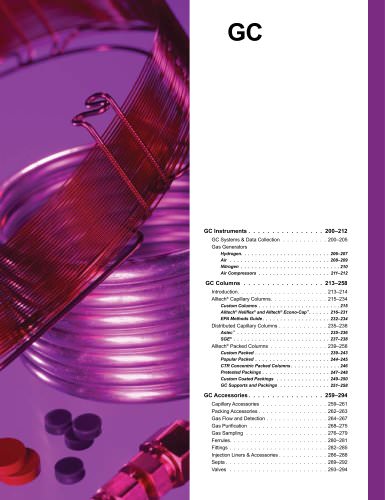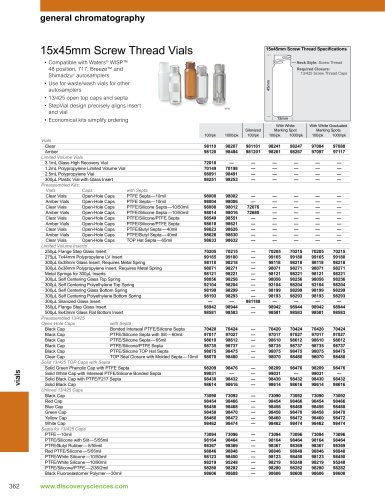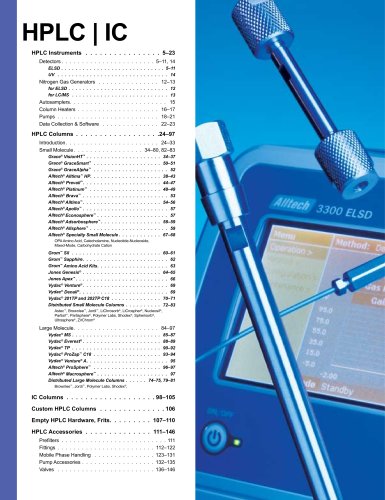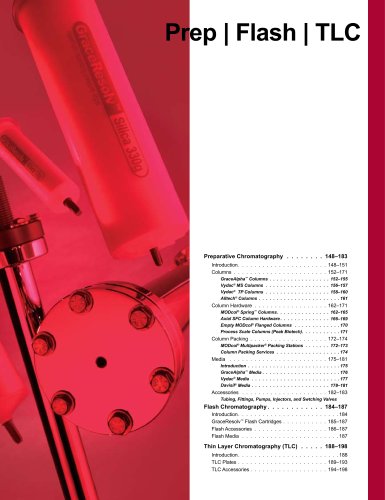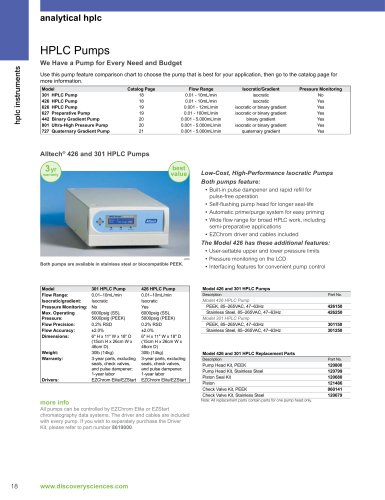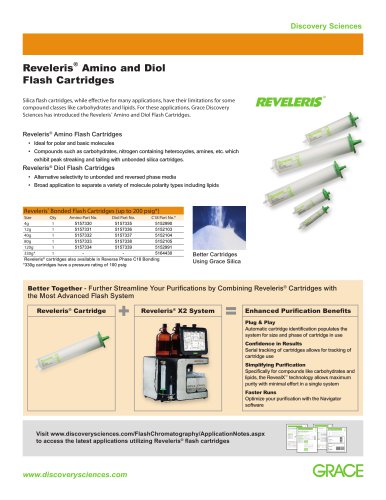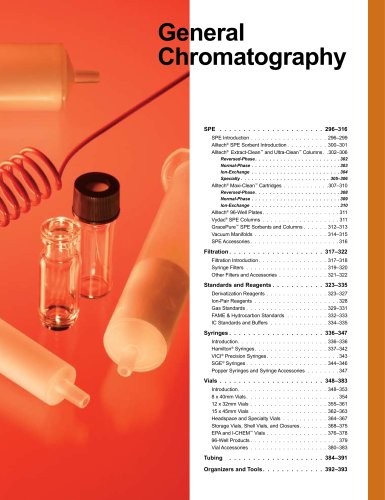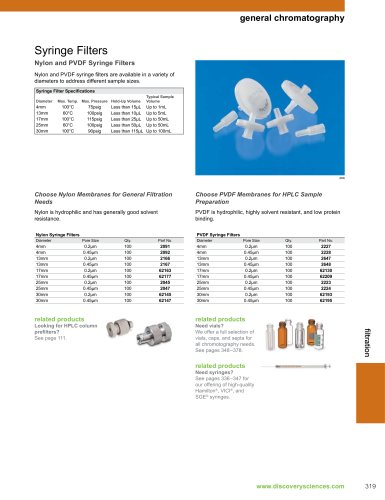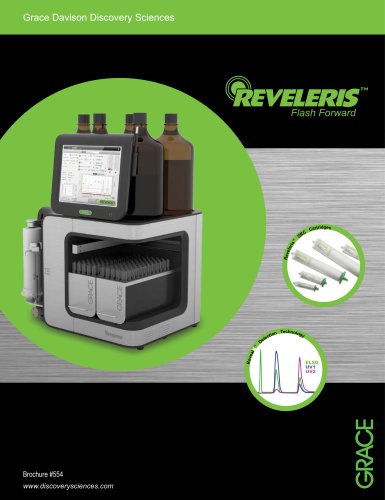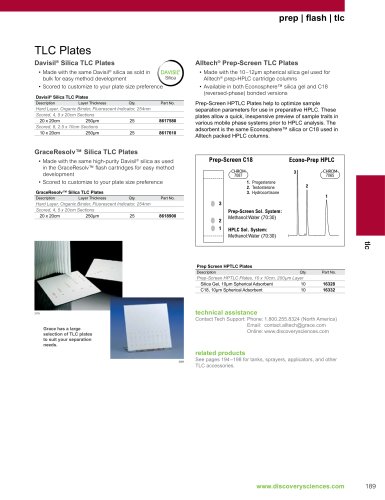TLC Introduction0 pages
188 www.discoverysciences.com
prep | flash | tlc
tlc
Thin Layer Chromatography to Preparative
Chromatography
One of the first steps in scale-up of preparative liquid
chromatography separations is selection of an appropriate
mobile phase. Two methods are commonly used to
determine the proper mobile phase composition: Thin
Layer Chromatography (TLC) or High Performance Liquid
Chromatography (HPLC). The use of TLC will be discussed
here to deal with the successful correlation between the TLC
separation to the preparative silica column.
TLC is a liquid-solid adsorption technique where the mobile
phase ascends the thin layer of stationary phase coated onto
a backing support such as glass by capillary action. There
is a similar relationship to column chromatography where
the solvent travels down through the column’s adsorbent.
The similar relationship allows TLC to be a rapid method for
determining solvent composition for preparative separations.
Steps for Method Development
Choose Stationary Phase
Choose a scalable TLC plate, preferably that has an identical
media as the preparative column. Choose between normal
and reverse phase based on sample polarity and solubility.
Choose a Mobile Phase
Criteria for Choosing a Preparative Solvent
• Solubility
• Affinity
• Resolution
1. Solubility
Many solvent systems provide the minimal solubility for the
sample, but to elute a sample from a column the mobile
phase must have a greater solubility for the sample, as the
sample concentration is usually very high. When possible, it
is best to dissolve the sample in the mobile phase. The first
step in solvent selection is determination of the solubility of
the sample. The desired mobile phase would provide the
greatest solubility, while providing affinity for the sample on
the stationary phase.
Solvent Solubility Screening Table
Water
Methanol
Ethanol
Acetone
Diethyl Ether
Ethyl Acetate
Dichloromethane
Toluene
Chloroform
Cyclohexane
Petroleum Ether
Hexane
2. Affinity
To achieve a separation, the sample must have a relatively
equal affinity for the solvent and the packing material. If the
sample has a higher affinity for the stationary phase than the
solvent, the sample will remain at the origin (Rf value will be
too low).
3. Resolution
Resolution is improved by optimizing the affinity between
sample, solvent, and support. The optimum solvent for
separating two or more compounds will maximize the
difference in the compounds. Most TLC and preparative
mobile phase systems contain a polar solvent and a
chromatographically dissimilar less-polar solvent. As a
guide for method development, a substitution in the polar
solvent often results in a change in resolution, while a change
in the less-polar solvent results primarily in a change in Rf
of the sample components. The table below shows some
common tendencies of various functional groups to adsorb
onto the silica.
Affinity of Functional Groups for Silica Gel
-NH2 Amine
-COOH Carboxylic Acid
-COH Alcohol
-CONH2 Amide
-C=O Carbonyl
-C=-CO2R Ester
-C-O-C Ether
-C1 Halocarbons
-CC- Hydrocarbons
Select Visualization Technique
Once a mobile phase is selected, visualization techniques
will need to be determined. Common techniques include
SWUV, I2 /SWUV, I2 /KI for Nitrogen containing compounds,
H2SO4/LWUV, H2SO4/PMA for non-nitrogen containing
compounds.
Perform TLC Analysis
Look up the affinity for the type of compound as well as
the solvent strengths to find a starting point for method
development or look up a reference from a similar structure,
then adjust the mobile phase composition to adjust the Rf. It
is common to try 3–6 solvent systems for the first round of
method development. Review the results after visualization
and adjust the Rf if necessary, increase the separation and
evaluate visualization techniques to make sure you are seeing
all necessary compounds.
Optimizing TLC Separations for Preparative
Separations
The optimum separation of compounds by TLC is usually
achieved when Rf values are between 0.3–0.5.
Rf = Distance from origin to center of spot
Distance from origin to solvent front
Generally, adjusting the compound’s Rf between 0.3–0.5 is
done first for a TLC separation. For scale-up to preparative
separations, the TLC solvent system’s polarity must be
decreased to lower the Rf between 0.15–0.35. This Rf range
is optimal for a preparative separation, in terms of sample
load, resolution, residence time, and solvent usage.
Determination of Column Volumes (C.V.)
The equation C.V. = 1/ Rf relates the TLC values and the
preparative LC column volumes to elute each component.
This equation is only a guideline and the relationship
between the Rf values and the column volume will vary in
use. Generally, the LC column volumes will be equal to or
less than the calculated values. The elution volume will also
be dependent upon the sample load and solvent used to
solubilize the sample.
Increasing Polarity
Increasing Affinity
TLC Introduction

 عضویت
عضویت  ورود اعضا
ورود اعضا راهنمای خرید
راهنمای خرید







